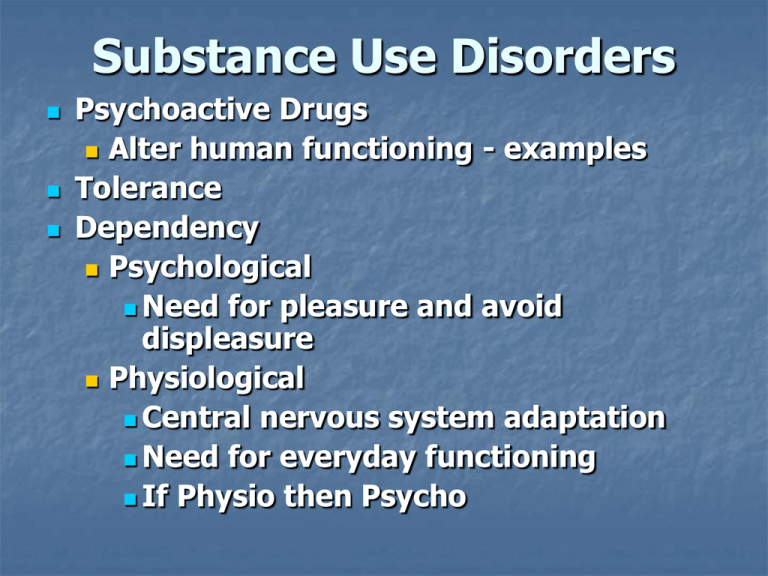
Substance Use Disorders
Psychoactive Drugs
Alter human functioning - examples
Tolerance
Dependency
Psychological
Need for pleasure and avoid
displeasure
Physiological
Central nervous system adaptation
Need for everyday functioning
If Physio then Psycho
Alcohol
Most abused recreational drug
Central Nervous System Depressant
BAC
Disorders
DT’s (Delirium tremens)
Alcoholic
Hallucinosis
Pathological intoxication
Deterioration
Korsakoff’s
Physiological dependence
Standard Drinks
1.0-1.5 oz hard liquor, 12 oz of beer,
3-6 oz of wine.
Barbiturates
Physiological dependence
“Downers.” 2,000 accidental suicides
How to get off of them
Phenobarbital, Seconal
Can die from withdrawal
Amphetamines
“Uppers”
Psychological Dependence
Benzedrine, Dexedrine, Methodrine,
Cocaine
Narcotics
Analgesics
Greek word for stupor
Bind at opiate receptors
Cocaine and Marijuana often classified
as "narcotics" in the Controlled
Substances Act (CSA) but neither bind
opiate receptors nor produce morphinelike effects
Pain meds, heroin
Physiological dependence
Hallucinogens
LSD, PCP (phencyclidine), mescaline
(peyote cactus), psilocybin (certain
mushrooms)
Effects are unpredictable--depends on
amount taken, the user's personality,
mood, and expectations, and the
surroundings in which the drug is used.
Usually, the user feels the first effects of
the drug 30-90 minutes after taking it.
Flashbacks
Psychological Dependency
Marijuana
Cannabis sativa
THC (delta-9-tetrahydrocannabinol)
Most commonly abused illicit drug
More effects on body than smoking
2005--16.5% of 8th graders, 34.1% of 10th
graders, and 44.8% of 12th graders reported
lifetime use of marijuana-decrease
Schedule I substance under the
Controlled Substances Act (CSA).
Schedule I drugs are classified as having a
high potential for abuse
Sexual and Gender Identity
Disorders
Gender Identity Disorder
A. Strong persistent cross-gender identification
(not merely a desire for any perceived cultural
advantages of being the other sex).
B. Persistent discomfort with his or her sex or
sense of inappropriateness in the gender role
of that sex.
C. The disturbance is not concurrent with
physical intersex condition.
D. The disturbance causes clinically significant
distress or impairment in social, occupational,
or other important areas of functioning.
Prior to DSM-IV-TR this was
transsexualism.
Male/Female
Female/Male
Sex Reassignment Operations
Sexual Dysfunctions
Males
Male Erectile Disorder or Dysfunction
- Persistent or recurrent inability to
attain or maintain an adequate
erection for penetration (performance
anxiety).
Premature Ejaculation - Persistent
and recurrent onset of orgasm and
ejaculation with minimal sexual
stimulation, occurring before, at, or
shortly after penetration.
Females
Female Orgasmic Disorder - Persistent
or recurrent delay in or absence of
orgasm following a normal sexual
excitement phase.
Vaginismus - involuntary spasms of
the musculature of the outer third of
the vagina that interferes with sexual
intercourse.
Altogether 45% of men and 55% of
women reported some sexual dysfunction
during the past year.
Women
33% report lack of sexual interest
24% report inability to experience
orgasm
Men
29% reported climaxing to early
17% reported sexual anxiety
(performance)
16% reported lack of sexual interest
Paraphilias
Much more common in Males
Behaviors in which the individual's
sexual interest directed toward:
Objects other than humans
Intercourse under unusual or bizarre
circumstances
Sexual acts not usually associated
with intercourse
Fetishism
Being aroused by holding, tasting,
smelling, viewing
Generally masturbate
Clothing
Parts of body
Transvestic Fetishism
Heterosexual arousal pattern
Frotteurism
Recurrent, intense sexual arousing by
touching/rubbing nonconsenting person
Pedophilia
Masturbation or oral/genital contact
If child is blood relative incest
Married/religious
Must be 16 and at least 5 years older
than victim
Victim usually 13 or younger
Exhibitionism
Voyeurism--Scoptophilia
Flashing
Most commonly reported to police
Females (about 40%/60% F/M)
Looking at unsuspecting person
Zoophilia--Bestiality
Animals
Masturbation not enough
Sexual Masochism
Humiliated, beaten, bound, or otherwise
made to suffer
Sexual Sadism
Wants to humiliate, beat, bound, or
otherwise make suffer
Rape
25% of all females report some type of
sexual assault
About 7 rapes prior to getting caught
About 20 total rapes each
For every rape that is reported, 4-20 go
unreported
Derogate victim
Violent impulses/sex not major motive
in many rapes
Should report—why?
Eating Disorders
Anorexia Nervosa
15% below ideal
"Feel Fat“/Preoccupied w/ body size
Vomiting, laxatives, diuretics
Fix elaborate meals for others
Females 95%
Mortality 5-18%
Suicide, electrolyte imbalance, cardio
Hospitalization
Adolescence--mean age is 17 years old
Stressful life event like leaving home for
college
1 in 800 to 1 in 100
Absences of periods 3 consecutive
Excessive exercise
Restricting Type
Binge-eating/purging type--one or
both of these
Bulimia Nervosa
Binge eating/purging
Typically includes sweets/high calorie
(cake/ice cream)
Compensatory behaviors to prevent
weight gain
Self-induced vomiting
Exercise
Feeling of lack of control
Over concern with body shape and
weight
Minimum average of 2 binges a week for
3 months
Little chewing, rapid eating
Vomiting reduces past binge anxiety
Hide the eating
Adolescence/early adult
1-3% females .04% males
90% females
Purging type
Nonpurging type
Therapy
Is More Therapy Better?
Medical Therapies
Medical
Drugs
Phenotiazines
Relieve positive but not negative
symptoms
Lithium
Tricyclics
Benzodiazepines
ECT
Surgery
Behavioristic (Wolpe)
49% of faculty in accredited clinical
psychology programs now align
themselves with a cognitive or
cognitive-behavioral therapy orientation
Systematic Desensitization
Aversion Therapy
Implosive/Flooding/Exposure
Token Economies
Young and Retarded
Cognitive Behavior Therapy (Ellis)
A=Antecedent Condition or Event =
Divorce
B=Beliefs or Behaviors = “I’m a bad
person.”
C=Consequence = Depression
If we get the person to challenge and
change the irrational beliefs the
consequences have got to change.
Psychoanalysis (Freud)
Free Association
Insight into unconscious motives and
feelings
Transference
Catharsis
Humanism (Rogers, Maslow)
Client-Centered Therapy/Non-Directive
Potentials/Self-Actualization
Conditional/Unconditional Positive
Regard
Conditions of Worth
What form of therapy is the most
effective?
Combination of therapeutic interventions
with medications tend to be the best.




